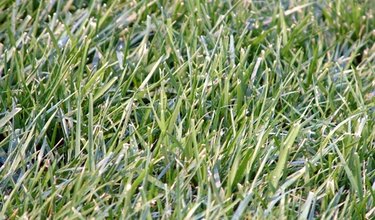Things You'll Need
Rake
Starter fertilizer
Lawn spreader
Grass seed accelerator
Sprinkler
Water hose

One of the most inexpensive ways to grow grass in your lawn is to start from seed. In most climates, the best time to plant your seed is in the fall. Lawn seed is relatively inexpensive to purchase, and you'll pay significantly less for a lawn from seed than you will pay for a lawn started with sod. If you choose to do the project yourself, you'll save even more money. The best way to plant grass seed in November is to prepare your lawn and keep the area watered so the seed will germinate and grow.
Step 1
Find the right time to plant. In many parts of the country, freezing temperatures hit late in November and can linger through February or later. You want to give your grass seed enough time to grow and put down some roots before freezing temperatures hit. Check with your local weather service to find out average temperatures. You may need to plant early in the month to avoid freezing your grass before it establishes itself.
Video of the Day
Step 2
Buy a top-quality grass seed. The National Turfgrass Evaluation Program evaluates and rates grass seed so you know which ones are the quality you want and suited for your area. To make sure you have the grass seed you need, make sure the seed is NTEP rated. Buying a low-quality grass seed could mean that seeds of other plants, even weeds, are in the mix.
Step 3
Prepare your soil, which should still be easy to work with in November. Freezing temperatures can make soil hard in December, January and February. However, fall rains can help loosen up the soil in November. Loosen the top 2 to 3 inches of your soil with a rake and remove any debris from the area, such as sticks and stones. If there are clumps of soil larger than a half dollar, use your hands to loosen them up.
Step 4
Apply a fertilizer to the soil before you plant grass seed. A starter fertilizer designed for use with lawn seed will give your grass an extra boost. Use a fertilizer with crabgrass preventer to help fight weeds while your lawn grows. You can use a lawn spreader to spread fertilizer over your loosened soil.
Step 5
Empty the fertilizer out of your lawn spreader and fill it up with your grass seed. Set your lawn spreader so it applies about 16 seeds per square inch of soil. Walk behind the lawn spreader to seed your lawn. Use your hands to distribute lawn seeds to small areas where a lawn spreader cannot reach.
Step 6
Cover your grass seeds with 1/4-inch of soil. Use a rake to lightly drag some of the loose soil on top of your seeds. You can also cover your grass seeds with a grass seed accelerator, which may be especially helpful if there are freezing temperatures in the weeks ahead. It helps keep the seeds in place and retains moisture so the seeds can germinate and grow.
Step 7
Water frequently. The soil your grass seed sits in should remain moist to give your lawn the best chance of growing strong. Water without saturating at least once a day until your new grass stands about 2 inches tall.
Video of the Day